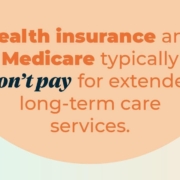How the CARES Act Affects Retirement Accounts – Part 1 – 04/01/20
Money Matters – Skloff Financial Group Question of the Month – April 1, 2020
By Aaron Skloff, AIF, CFA, MBA
Q: How does the CARES Act impact our estate, financial, retirement tax planning, and particularly retirement accounts?
A: The Problem – The CARES Act Brings Big Changes to Retirement Accounts
To combat the coronavirus pandemic and its economic damage, on March 27, 2020, the U.S. government created the Coronavirus Aid, Relief, and Economic Security (CARES) Act. Let’s review the biggest changes to retirement accounts.
The Solution – Implement Estate, Financial, Retirement and Tax Planning Strategies Based on the CARES Act
The CARES Act provides retirement account withdrawal flexibility and tax relief for those impacted by the coronavirus.
Withdrawals. Retroactive to January 1, 2020, individuals taking withdrawals of up to $100,000 from IRAs and/or employer sponsored retirement plans (i.e.: 401(k), 403(b), 457(b), SEP IRA, SIMPLE IRA) through December 31, 2020 gain relief if they:
1. are diagnosed with the virus SARS-CoV-2 or with coronavirus disease (COVID-19) or
2. have a spouse or dependent is diagnosed with such virus or disease or
3. experiences adverse financial consequences as a result of being quarantined, furloughed or laid off or having work hours reduced due to such virus or disease, being unable to work due to lack of child care due to such virus or disease, closing or reducing hours of a business owned or operated by the individual due to such virus or disease.
Critical Warning. Financial markets can recover very quickly. Missing just a few days of a recovery can equate to years of positive returns.
Redepositing Withdrawals. Withdrawals from retirement accounts can be redeposited any time during the three-year period, beginning on the day after the date on which the distribution was received. By delaying repayment of withdrawals, you risk missing a market recovery.
Loans. Loans from employer sponsored retirement plans are normally subject to a 50% limit on vested account balances up to $50,000. The CARES Act allows loans up to 100% of vested account balances up to $100,000 during the 180-day period after the law was enacted.
Taxes and Penalties. Withdrawals from pre-tax retirement accounts are normally subject to federal, state (if applicable) and municipal (if applicable) income taxes in the year of the withdrawals. Additionally, withdrawals completed before the age of 59 ½ are subject to a 10% federal tax penalty. The CARES Act waives the 10% federal tax penalty and allows withdrawals to be included as income subject to federal income taxes ratably over a three-year period.
RMD Waivers. Required Minimum Distributions (RMDs) are normally required for those who were age 70 ½ as of December 31, 2019 and those age 72 beginning on January 1, 2020 (due to the SECURE Act). The CARES Act waives RMDs for all ages and inherited IRAs for 2020, including those that delayed 2019 RMDs that were due by April 1, 2020. RMDs completed in 2020 prior to the CARES Act can be redeposited into within 60 days or within three years (see Redepositing Withdrawals). Withdrawals from inherited IRAs cannot be redeposited.
Estate, Financial, Retirement and Tax Planning Strategies. RMDs cannot be used for Roth IRA conversions. RMDs permanently force assets out of retirement accounts, even if the holdings are temporarily depressed. Although you can complete RMDs and Roth IRA conversions in the same year, they are both taxable transactions (with few exceptions). The CARES Act provides a one-time opportunity to substitute RMDs with Roth IRA conversions. Assets that would normally be permanently forced out of retirement accounts due to RMDs can instead be converted to Roth IRAs. Let’s look at an example of an RMD that would have been $100,000 for 2020. You can avoid the $100,000 RMD and instead complete a $100,000 Roth IRA conversion. You can convert temporarily depressed assets, such as a stock portfolio that was worth $200,000 on December 31, 2019, but is worth $100,000 on the day of the Roth IRA conversion.
The tax implications of RMDs and Roth IRA conversion are equal in the year completed, but the future planning benefits can be huge. See ‘The SECURE Act Brings the Biggest Changes to IRAs Since Their Inception’ Part 1, Part 2 and Part 3. By proactively taking advantage of temporary depressed stocks and converting them into a Roth IRA, you turn stock market pain into your gain. The benefits include:
1. Locking in Tax Free Growth. Once inside a Roth IRA, all gains and withdrawals for owners and beneficiaries are tax free. If a stock portfolio inside a Roth IRA grows from $100,000, then back to $200,000, then $10 million, all the growth and withdrawals are tax free.
2. Locking in Lower Income Tax Brackets. Married couples can convert at historically low income tax brackets versus future brackets that are expected to be higher (taxpayers will ultimately have to pay for all this tax relief with higher tax rates), when higher RMDs increase their income. A single filer or surviving spouse can have much higher tax brackets for the same amount of income as a married couple. Many inherited IRA owners are in their peak income years when they are forced to withdraw the entire account value within 10 years. Withdrawals from pre-tax inherited retirement accounts can push them into even higher tax brackets. But, withdrawals from inherited Roth IRAs are tax free.
Action Step — Work Closely with a Registered Investment Adviser (RIA) to Best Utilize the CARES Act
Work closely with an RIA to utilize the estate, financial, retirement and tax benefits provided by the CARES Act.
Aaron Skloff, Accredited Investment Fiduciary (AIF), Chartered Financial Analyst (CFA), Master of Business Administration (MBA) is CEO of Skloff Financial Group, a Registered Investment Advisory firm. He can be contacted at www.skloff.com or 908-464-3060.












